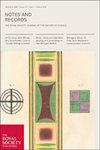17世纪至20世纪卡斯尔福德米尔斯的工业水力工程和技术
IF 0.6
3区 哲学
Q3 HISTORY & PHILOSOPHY OF SCIENCE
Notes and Records-The Royal Society Journal of the History of Science
Pub Date : 2015-12-16
DOI:10.1098/rsnr.2015.0044
引用次数: 3
摘要
本文通过介绍最近发现的设计计划和实践,并辅以其他历史研究,讲述了17世纪到20世纪卡斯尔福德水厂的工程和技术故事。卡斯尔福德的一家磨坊是由托马斯·艾林森博士的天然食品公司经营的,因此,当白面粉的流行促使其他磨坊改用辊磨系统时,它保留了石磨。磨盘由一个高效率的胸射轮提供动力,据信这是英国工业服务中最后一个这种类型的车轮。它的许多特点,以及后来的长寿,都可以归因于威廉·费尔贝恩和约翰·斯米顿的影响深远的作品。详细的彩色设计显示了这个水轮和它的民用住宅的建筑规格,以及其他工程计划,如以前未记录的亨利西蒙水平涡轮机。与John Smeaton的联系以及他在Castleford Oil Mill设计目录中的条目也被探索,并且在现场确定了一个以前的洪水磨坊。本文章由计算机程序翻译,如有差异,请以英文原文为准。
Engineering and technology of industrial water power at Castleford Mills from the seventeenth century to the twentieth century
This article tells the story of engineering and technology at Castleford Water Mills from the seventeenth century to the twentieth century through the presentation of recently discovered design plans and deeds, supplemented by other historical research. One of Castleford's mills was operated by Dr Thomas Allinson's Natural Food Company and therefore retained stoneground milling when fashions for white flour prompted other mills to switch to roller systems. The millstones were powered by a high-efficiency breastshot wheel, believed to be the last of its type taken out of industrial service in Britain. Many of its features, and its subsequent longevity, can be attributed to the influential works of William Fairbairn and John Smeaton. Detailed colour designs show the construction specifications of this water-wheel and its civil housing, along with other engineering plans such as a previously unrecorded Henry Simon horizontal turbine. Links with John Smeaton and the entry in his catalogue of designs for Castleford Oil Mill are also explored, and a former flood mill is identified at the site.
求助全文
通过发布文献求助,成功后即可免费获取论文全文。
去求助
来源期刊
CiteScore
1.50
自引率
0.00%
发文量
45
审稿时长
>12 weeks
期刊介绍:
Notes and Records is an international journal which publishes original research in the history of science, technology and medicine.
In addition to publishing peer-reviewed research articles in all areas of the history of science, technology and medicine, Notes and Records welcomes other forms of contribution including: research notes elucidating recent archival discoveries (in the collections of the Royal Society and elsewhere); news of research projects and online and other resources of interest to historians; essay reviews, on material relating primarily to the history of the Royal Society; and recollections or autobiographical accounts written by Fellows and others recording important moments in science from the recent past.

 求助内容:
求助内容: 应助结果提醒方式:
应助结果提醒方式:


